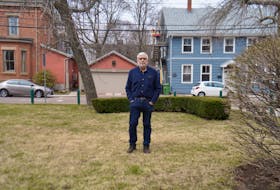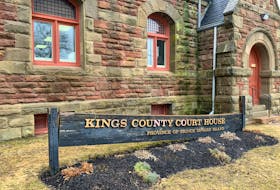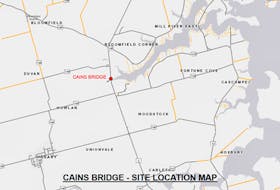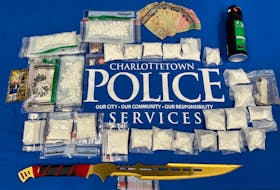CHARLOTTETOWN, P.E.I. — Charlottetown Mayor Philip Brown says the city helped add more than 100 affordable housing units during the past year.
In a recent year-end interview, the mayor said those units are not funded directly through government sponsorship. It has been done based on working with private developers, subsidization, forgivable grants, loans and low-lending rates.
“The housing crisis is not going away,’’ Brown said. “We have to address it. Social housing is also a responsibility of our provincial and federal governments. I’ve been pushing that every time we speak to the other levels of government.
“They’re interested in providing these low-interest loans or forgivable grants to private developers but those are short-term answers. We need a long-term plan.’’
 Dave Stewart, left, The Guardian's municipal reporter, sat down recently with Charlottetown Mayor Philip Brown for the annual year-in-review interview. - Ryan Ross • The Guardian
Dave Stewart, left, The Guardian's municipal reporter, sat down recently with Charlottetown Mayor Philip Brown for the annual year-in-review interview. - Ryan Ross • The Guardian
Based on statistics the city’s planning department provided to The Guardian, affordable housing units have been completed or are in the works on Patterson Drive as well as on Norwood, Kensington, Towers and Sherwood roads.
The city has been pushing the province to add inclusionary zoning into the planning act portion of the Municipal Government Act.
That would require private developers to set aside a minimum of 10 per cent of their multi-unit apartment complexes for affordable housing. Arsenault Bros., for example, recently received approval from council to proceed with a 186-unit apartment building where 10 per cent of the units will have a rent that is tied directly to the renter’s income.
Brown said he has support on the inclusionary zone request from the Opposition Greens and Liberals and has had discussions on it with Social Development and Housing Minister Ernie Hudson.
“These are issues that we have to work on. Housing is an issue for me. It’s not going away magically. We need real action plans.’’
This year, the city created an affordable and accessible housing fund which sees it spending $350,000 towards helping developers add units to their projects. It is used in the form of tax credits during a 20-year period.
One of the challenges for developers, the mayor said, is the COVID-19 pandemic has driven up the cost of labour and building supplies.
Overall development is also on the rise, jumping nine per cent in Charlottetown this year. Most of that is in single-family dwellings, duplexes, triplexes, townhouses and apartments. It’s beginning to show.
"Social housing is also a responsibility of our provincial and federal governments. I’ve been pushing that every time we speak to the other levels of government."
The vacancy rate in the capital jumped from a woeful 0.3 per cent in 2018 to 1.2 per cent in 2019, based on numbers from the Canada Mortgage and Housing Corporation.
By comparison, Moncton is at 2.2 per cent, Saint John, N.B., at 3.3 per cent and Halifax at one per cent.
Brown said keeping up with demand is difficult considering the city’s population increased 19 per cent between 2005 and 2019 and has jumped eight per cent in the last three years alone.
The Guardian also asked Brown why there has been no traction on the short-term rental unit issue, which many people believe has negatively impacted the housing situation.
The city intends to create a bylaw on the issue but that requires a public meeting. Considering it’s a hot-button issue, it will be a well-attended meeting and Brown said that isn’t possible with the current public health restrictions.
He cites the nine-storey student residence at UPEI as an example. The city held a virtual public meeting, which was appealed to the Island Regulatory and Appeals Commission (IRAC) by residents who felt the public meeting requirements weren’t followed. IRAC ended up ruling in the city’s favour.
Homelessness
Brown said the city is working with the provincial government and various non-government organizations to deal with the needs of the people who were displaced when the city recently sealed off a culvert unhoused people were using as a shelter near Hillsborough Bridge.

The province’s outreach centre in Charlottetown is involved as is Blooming House, Bedford MacDonald House and the Salvation Army.
When The Guardian asked Brown what happened to the people displaced by the closure of the culvert, he said: “We’re part of the solution of finding some accommodations for some of the individuals who were using it as a home base.’’
Statue
Controversy this year has surrounded the Sir John A. Macdonald statue at the corner of Queen Street and Victoria Row.
Macdonald, Canada’s first prime minister, was also the founder of the residential school system, which separated Indigenous children from their parents and led to abuse, death and problems that have festered for more than a century.

In June, council voted to leave the statue where it is before engaging Indigenous groups on the path forward.
Brown didn’t rule out going in a different direction, pending discussions with Indigenous residents, but did add that Macdonald’s role in the 1864 Charlottetown Conference is also important to the city.
Fire station
The city is moving toward the design phase for a third fire station that will be located on Malpeque Road.
The union that represents full-time firefighters in Charlottetown is pushing to have all three stations staffed with a minimum of four firefighters on each shift to ensure there is a sufficient initial response to each call.
Brown said that is a collective bargaining issue that he doesn’t want to get into publicly, adding council’s focus is to get the third station built.
Capital projects
Brown said the new fire station is the city’s top priority but not the only project on the books this coming year.
The long-awaited roundabout connecting Belvedere Avenue, St. Peters Road and Brackley Point Road, at what is known as the Vogue Optical corner, is being looked at again by the public works committee.

The mayor said they hope to have some kind of resolution at council’s meeting in January.
The city is also looking at adding a third ice pad at the Bell Aliant Centre to eventually replace the aging Simmons Sport Centre. No decision has been made on the future of Cody Banks Arena in Sherwood.
Dave Stewart is The Guardian's municipal reporter








